맨 손이나 유축기로 젖을 짜야 하는 경우, Breast milk expressed by manual technique or breast milk pump
- 수유모가 젖꼭지를 직접 빨려 아기에게 모유를 먹이면 가장 좋겠지만 때로는 부득이한 사정으로 어쩔 수 없이 맨손이나 유축기로 젖을 짜서 아기에게 짠 젖을 젖병으로 먹여야 한다.
- 엄마의 젖을 미리 짜서 젖병에 담아 냉장고에 보관했다가 그 짠 젖을 수유모나 수유모 이외 사람이 아기에게 먹일 수 있다.
| 어떤 경우에 이런 대안을 써야 할까. |
- 엄마의 젖이 퉁퉁 불어 유방이 아픈 ‘유방 과잉 충만’ 현상이 나타날 때 치료 목적으로 손이나 유축기로 젖을 짤 수 있다.
- 수유모가 전업 직장에서 일할 때, 장시간 외출해야 할 때 4~5시간 이상 아기에게 젖을 먹일 수 없을 경우에도 이 방법을 쓸 수 있다.
- 출근하기 전이나 외출하기 전 미리 젖을 맨손으로 짜거나 유축기로 짜서 보관했다가 아기에게 짠 젖을 제 때에 먹일 수 있다.
- 그 동안 엄마의 젖을 먹었던 아기에게 인공영양을 보충으로 먹이면 인공영양을 먹기 싫어하는 아기도 있고 어떤 아기들은 아예 인공영양을 먹기를 거절하기도 한다. 인공영양에 알레르기가 생겨 먹지 않는 아기도 있다. 이런 아기에게는 보충용 인공영양을 먹이는 대신 엄마 젖을 짜 보관해 놓았다가 짠 엄마 젖을 젖병에 담아 먹일 수 있다.
- 아주 작은 저체중 미숙 신생아들 중 일부는 흡철 반사나 포유 반사 등 원시 반사가 없고, 젖꼭지를 빨아먹을 수 있는 힘조차 없어 엄마의 젖꼭지를 스스로 입안에 넣고 빨아먹지 못한다. 어떤 질병으로 인해 엄마의 젖을 먹을 힘이 없는 아주 미약한 미숙 신생아(조산아/Premature infants/Preterm), 극소 저 출생체중아(Very low birth weight infants), 최 극소 저 출생체중아(Extremely low birth weight infants), 저 출생체중 신생아(Low birth weight infant) 도 있다. 이런 미숙 신생아들은 엄마가 아무리 모유수유를 적절히 해도 젖꼭지를 잘 빨 수 없어 젖을 충분히 빨아먹을 수 없다. 이 경우 맨손이나 유축기로 엄마의 젖을 짜서 멸균 젖병에 담아 짠 젖을 바로 미숙 신생아에게 먹이든지, 짠 젖을 보관했다가 스포이드, 튜브 영양법(튜브 피딩), 젖병 등으로 짠 젖을 먹일 수 있다. (부모도 반의사가 되어야한다 -소아가정간호백과-제 6권 신생아 성장 발육 양호 질환- 아주 작은 미숙 신생아 참조)
- 불가분한 문제로 수유모와 젖 먹는 아기가 4~5시간 이상 서로 떨어져 있어야 할 경우도 있다. 이 경우 엄마가 아기에게 젖을 직접 먹일 수가 없으므로 역시 엄마의 젖을 맨손이나 유축기로 짜서 젖병에 담아 아기에게 먹일 수 있다.
- 엄마가 아프거나 아기가 아파서 엄마의 젖을 아기에게 먹이지 못하거나 아기가 아파서 엄마의 젖을 아기가 빨아 먹을 수 없을 수 있다. 역시 엄마의 젖을 맨손이나 유축기로 짜서 젖병에 담아 아기에게 먹일 수 있다.
- 유방의 전방 부분에 괴여 있는 젖만 먹이고 유방의 후방 부분에 괴여있는 젖을 먹이지 않으면 단위 용량 당 칼로리 양이 적은 전방 부분 젖만 먹게 되고 아기가 칼로리가 더 높은 유방의 후방 부분에 괴여 있는 젖을 충분히 먹지 못하게 된다. 이런 식으로 아기에게 젖을 먹이면 젖이 잘 분비되지 않는다. 그 뿐만 아니라, 아기가 엄마의 젖을 양적으로 충분히 먹을 수 있으나 칼로리 면에서는 충분히 섭취하지 못한다. 적절한 수유 간격으로 충분한 모유를 먹어도 금방 배고파하거나 체중이 제대로 늘지 않을 수 있다. 먹다 남은 후방 부분 젖을 짜 보관했다 먹일 수 있다.
- 모유수유를 할 때는 수유하기 직전, 도중, 직후에 유방 전체를 마사지하고, 유방 후방부분에 있는 젖을 손이나 유축기로 짜서 유방을 완전히 비워줘야 그 다음 줄 젖이 더 잘 분비된다.
- 유관이 막혀 생길 수 있는 유선염(유방염)이나 박테리아 감염성 유선염이 악화되지 않게 젖을 짜야 할 때도 있다.
- 젖꼭지가 헐고 갈라져 아플 때도 모유수유를 제대로 할 수 없다. 이때도 젖을 맨손이나 유축기로 짜서 그 짠 젖을 젖병으로 먹일 수 있다.
- 이제 손으로 젖을 짜는 방법과 유축기로 젖을 짜는 방법을 각 항에서 구체적으로 더 살펴보도록 하자.
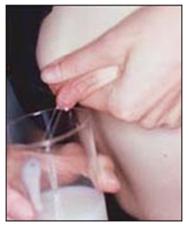
사진 4-80. 필요에 따라 맨손이나 유축기로 젖을 짠다.
Copyright ⓒ 2011 John Sangwon Lee, MD., FAAP
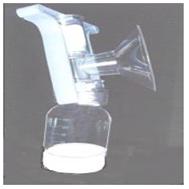
사진 4-81. 유축기에는 여러 가지 종류가 있다. 사진은 손으로 젖을 짜는 유축기
Copyright ⓒ 2011 John Sangwon Lee, MD., FAAP
| 맨 손으로 젖을 짜는 방법 |
How to manually express breast milk
- 먼저, 손을 깨끗이 씻고 유방 전체를 손으로 마사지한다(p00 유방 마사지 참조).
- 마사지가 끝나면 한쪽 엄지와 인지를 한쪽 젖꼭지에서 3.5cm 정도 떨어진 유방 부위에 올려놓고, 같은 쪽 손의 나머지 손가락으로 같은 쪽의 유방의 아랫부분을 받친다.
- 그 다음 앞쪽 흉벽을 향해 유방을 살살 누르고 젖꼭지가 있는 쪽으로 살짝 밀면서 젖을 짠다.
- 젖이 더 이상 나오지 않을 때까지 같은 유방 부분을 가만히 눌러 젖을 짜고 마지막으로 유륜 부분에 손가락을 올려놓고 거기서 젖을 짠다. 이 때 젖꼭지를 앞으로 잡아 빼서는 안 된다.
- 그 유방의 해당 부분에서 더 이상 젖이 나오지 않으면 그 유방의 바로 옆 다른 부분으로 손을 옮겨가면서 같은 방법으로 젖을 짠다.
- 한번 젖을 짜는 데 소요되는 시간은 여러 조건과 상황에 따라 다르지만 젖을 오랫동안 먹이지 않은 경우라면 20~30분 정도 걸린다.
- 짠 젖을 받을 컵은 젖을 짜기 전에 끓는 물로 살균해둔다. 살균 컵에 짠 젖을 받은 후 살균 젖병에 옮겨 담는다.
- 컵에 받은 젖을 아기에게 바로 먹일 수도 있고 그 젖을 젖병에 옮겨 담아 냉장고 냉동 칸에 2주간 보관할 수 있다.
- 또는 냉장고 급속 냉동 칸 내에 6 개월 동안 보관했다가 아기에게 먹일 수 있다. 단, 냉장고의 냉동 칸이나 급속 냉동 칸에 보관했던 젖을 한번 녹여 먹인 후에는 먹다 남은 젖은 다 버려야 한다. 또, 편의상 한 개의 젖병에 젖을 90~120cc 이상 담지 않는 것이 좋다.
- 여러 가지 이유로 아기에게 젖을 1일 이상 먹일 수 없어 젖을 짠 후 보관해야할 때, 젖을 얼마나 자주 짜야 좋은지 일률적으로 정할 수는 없지만 보통 24시간 동안 8번 정도 짤 수 있다.
- 낮에는 매 3시간마다 젖을 짤 수 있고 밤에 잘 때는 짜지 않아도 된다. 그러나 밤낮을 가리지 않고 3~4시간마다 젖을 짜야 젖이 더 잘 분비된다.
- 필요에 따라 몇 번 정도 젖을 짜서 한 개의 젖병에 담아 보관할 수 있다.
- 아기가 밤에 4~5시간 이상 내리자면 잠들기 전이나 아침 일찍 일어났을 때 젖을 짜서 보관한다.
- 젖을 다 먹인 후 바로 유방을 마사지하면 뇌하수체에서 프로랙틴 호르몬, 피토신 호르몬이 분비되어 젖이 더 잘 분비되도록 유방이 자극된다.
- 그 후 손으로 젖을 짜면 더 많은 젖이 분비될 수 있고 그 젖을 젖병에 담아 보관할 수 있다. 이 때 좌우 유방에서 번갈아 젖을 짤 수 있고 좌우 양쪽 유방에서 동시에 젖을 짤 수 있다. 젖을 짜기 직전이나 도중에 유방 마사지를 해도 젖이 더 많이 분비되고 더 많이 짤 수 있다.
- 분만 후 입원실에서 간호사로부터 또는 모유수유 전문가로부터 손으로 젖을 짜는 법과 짠 젖을 보관하는 법을 배워두면 퇴원한 후 필요할 때 가정에서 요긴하게 쓸 수 있을 것이다.
- 분만 후 수유모와 신생아가 병원에서 퇴원하기 전에 모든 수유모는 모유수유 전문가로부터 모유수유에 관한 특별교육을 필수적으로 받는 것을 의료법으로 정하면 좋겠다.
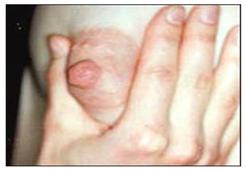
사진 4-82. 젖꼭지에서 3.5㎝ 정도 떨어져 있는 유방의 전방 부분에 엄지와 인지를 올려놓고 앞쪽 흉벽을 향해 유방을 살살 누르고 젖꼭지가 있는 앞쪽으로 살짝 밀면서 젖을 맨 손으로 짠다. 젖이 더 이상 나오지 않을 때까지 유방의 전방 부분을 눌러 젖을 짜고 마지막으로 젖꼭지와 유륜 부분에 손가락들을 올려놓고 젖을 다 짠다.
Copyright ⓒ 2011 John Sangwon Lee, MD., FAAP
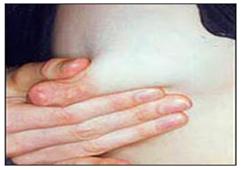
사진 4-83. 맨 손으로 젖을 짤 때 젖꼭지를 앞으로 잡아 당겨서는 안 된다. 젖을 맨손으로 짜기 전에 손을 비눗물로 깨끗이 닦는다.
Copyright ⓒ 2011 John Sangwon Lee, MD., FAAP

사진 4-84. 양쪽 손으로 젖을 가만 가만히 짠다.
Copyright ⓒ 2011 John Sangwon Lee, MD., FAAP
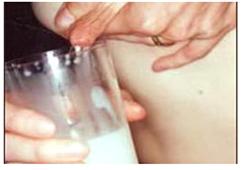
사진 4-85. 멸균 소독된 컵 속에 젖을 짜고 그 짠 젖을 젖병에 옮겨 담는다. 짠 젖에 박테리아가 감염될 수 있고 잘 보관하지 않으면 젖 속에 세균이 자랄 수 있다.
Copyright ⓒ 2011 John Sangwon Lee, MD., FAAP
| 수동 유축기로 젖을 짜는 방법 |
How to express breast milk by the manual breast pumps
- 젖을 짜는 기구를 유축기라 한다.
- 다른 말로 젖 짜개, 모유 펌프, 착유 펌프라고도 한다.
- 유축기의 작동원리에 따라
-
- 맨손으로 조작해서 젖을 짜는 ‘수동 유축기’,
- 배터리로 조작해서 젖을 짜는 ‘배터리 유축기’,
- 전기로 조작해서 젖을 짜는 ‘전기 유축기’ 등 여러 종류가 있다.
- 맨손으로 조작해서 젖을 짤 수 있는 수동 유축기는 값이 싸고, 어디를 가든지 쉽게 휴대할 수 있으며, 쓰기도 간편하다. 그러나 착유 효능이 썩 좋지 않은 것이 단점이다.
- 맨손으로 조작해서 젖을 짤 수 있는 수동 유축기의 종류
-
- Bicycle horn 유축기,
- Evenflo 유축기,
- Le Pump 유축기,
- Nurture 유축기,
- Ora’ Lac 유축기,
- Lloyd-B 유축기,
- Cylinder 유축기,
- Egnell Hand 유축기,
- Comfort Plus 유축기,
- Medela Manual or Electric 유축기 등은 맨손으로 조작해서 젖을 짤 수 있는 수동 유축기이다.
- Pedal Pump Breast Pump 등 발로 작동해서 유축 할 수 있는 유축기도 있다.
- 여기서는 대표적인 몇 가지 종류의 수동 유축기에 관해서 설명한다. (참고로 유축기의 상품명은 독자들의 편의를 도모하기 위한 것이지 저자와는 어떤 이해관계가 없다.)
① 맨손으로 작동하는 유축기
- 맨손으로 조작해서 젖을 짤 수 있는 수동 유축기의 일종이다.
- 한쪽 부분에 작은 흡인구가 있고 그 반대쪽 끝 부분에 깔때기 입구 모양의 부분이 달려있다.
- 깔때기 입구 모양으로 생긴 끝 부분을 젖꼭지와 유두륜을 포함한 유방 전방 부분에 밀착시키고 손으로 흡입구를 눌렀다 펼 때 젖이 짜진다.
- 깔때기 입구 모양의 끝 부분을 유방 전방부분에 밀착하기 전에 공기가 든 흡입구를 꼭 눌러 흡입구 내 공기를 전부 빼내 음압을 만든 다음, 깔때기 입구 모양의 끝 부분을 유방의 전방 부분에 밀착시켰다가, 흡입구를 펼 때 음압과 양압이 흡입구 내에 생겨 젖이 짜진다는 원리다. 손으로 젖을 짜는 수동 유축기는 배터리나 전기로 조작해서 젖을 짜는 유축기에 비해 젖을 짜는 데 손힘이 더 들고 젖이 잘 짜지지 않는 단점이 있다.
- 젖을 짤 때 잘못하면 유방에 상처를 입힐 수 있고 수동 유축기 입구에 박테리아가 오염될 수 있으며, 멸균 처리하기가 어렵다는 것도 단점이다. (그림5-9 참조)
② 실린더형 수동 유축기 Cylinder breast milk pumps
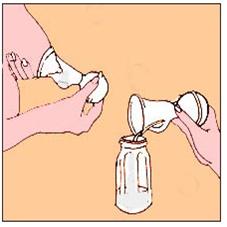
그림 4-26 손으로 조작해서 젖을 짜는 수동 유축기의 일종
Copyright ⓒ 2011 John Sangwon Lee, MD,, FAAP
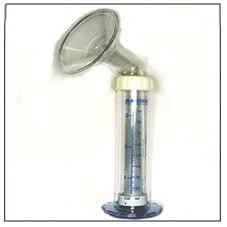
사진 4-86. 실린더형 수동 유축기
Copyright ⓒ 2011 John Sangwon Lee, MD,, FAAP
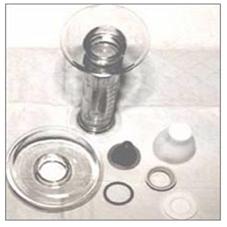
사진 4-87. 실린더형 수동 유축기를 분해한 것
Copyright ⓒ 2011 John Sangwon Lee, MD,, FAAP
- 실린더형 수동 유축기에는 크고 작은 두 개의 실린더가 겹쳐 있다.
- 큰 바깥 실린더 속에 작은 안 실린더를 넣고 큰 실린더에 달린 깔때기 모양의 입구를 유방의 전방 부분에 밀착시키고 유방 쪽에서 잡아당길 때 젖이 짜진다.
- 실린더형 수동 유축기는 유방 전방 부분에 대는 부분이 곧게 만들어진 것과, 약간 경사지게 만들어진 것 두 종류가 있다.
- 실린더형 수동 유축기로 젖을 짤 때는 두 손으로 조작해서 젖을 짜는 것이 보통이다.
- 젖을 짤 때 손에 힘이 많이 들어가기 때문에 조금 불편한 점이 있으나 비교적 젖이 잘 짜지기 때문에 많이 이용되는 수동 유축기이다.
- 배터리를 작동해서 젖을 짜는 실린더형 유축기도 있다.
- Egnell Hand 유축기와 Comfort Plus 유축기는 실린더형 수동 유축기의 일종이다.
③ 방아쇠형 수동 유축기 Manual trigger breast milk pumps
- 방아쇠형 수동 유축기에는 플라스틱 손잡이가 달려있고, 반대쪽에는 깔때기 입구 모양으로 생긴 끝 부분이 있다.
- 깔때기 입구 모양으로 생긴 끝 부분을 유방의 전방 부분에 밀착시키고, 방아쇠 모양의 손잡이를 손으로 눌렀다 펴면 젖이 짜진다.
- 자전거 경적형 수동 유축기로 젖을 짤 때보다 젖을 짜는 효과도 더 좋다.
- 이 방아쇠형 수동 유축기로 젖을 짜기 전에 옳게 젖 짜는 방법을 연습해야한다.
- 수유모의 손이 작으면 사용하는 데 좀 불편한 감이 있을 것이다.
- Lloyd-B 유축기는 방아쇠형 수동 유축기의 일종이다.
- 이밖에도 손으로 조작해서 젖을 짤 수 있는 수동 유축기의 종류는 더 많이 있다.
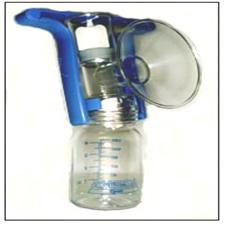
사진 4-88.방아쇠형 수동 유축기
Copyright ⓒ 2011 John Sangwon Lee, MD,, FAAP

사진 4-89. 방아쇠형 수동 유축기
Copyright ⓒ 2011 John Sangwon Lee, MD., FAAP
| 배터리 유축기로 젖을 짜는 방법 |
How to express breast milk by battery-operated breast milk pumps
-
요즘 흔히 쓰는 유축기 중 하나가 배터리 유축기(배터리 착유기 또는 전지 유축기)다.
-
배터리 유축기는 배터리의 힘을 이용해 완전히 자동적으로 젖을 짤 수 있는 유축기다.
-
배터리 유축기로 젖을 짤 때 손힘이 들어가지 않는 장점이 있다.
-
가벼워서 휴대하기에도 편리하다.
-
반면, 가격이 수동 유축기보다 조금 더 비싼 편이다.
-
필요에 따라 배터리를 바꿔야 한다.
-
배터리 유축기에는 Egnell Lact-B 배터리 유축기, Natural Choice 배터리 유축기, Gentle Expressions 배터리 유축기 등이 있다.
-
더 자세한 사용법에 관해서는 착유기 제조회사의 정보를 참조한다.
| AC 전기 유축기로 젖을 짜는 방법 |
How to express breast milk by AC electric breast milk pumps
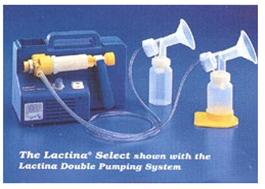
사진 4-90. 랙티나 2중 유축기.
소스 Breastfeeding Information Guide, Medela
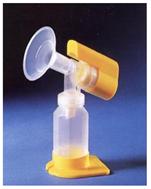
사진 4-91.소형 배터리(전지) 유축기
소스: Medela. Inc. P. o. Box. Mchenry. Il.60051-0660]
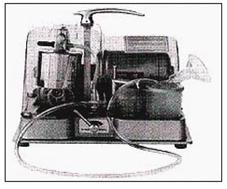
사진 4-92. 에그넬(Egnell) AC 전기 유축기
소스 에그넬(Egnell)
Copyright ⓒ 2011 John Sangwon Lee, MD., FAAP
- AC 전기로 조작해서 젖을 짤 수 있는 AC 전기 유축기다.
- 한 손으로 힘들이지 않고 쉽게 젖을 짤 수 있는 장점이 있다.
- 아기가 엄마의 젖꼭지를 빨아 젖을 먹을 때와 같이 젖이 쉽게 짜진다.
- 어떤 전기 유축기는 상당히 무겁고 값이 비싸다.
- 보다 더 가벼운 것도 있고 값이 싼 것도 있다.
- AC 전기 유축기에는
-
- Egnell 전기 유축기,
- Medela 전기 유축기(Mini electric breast pump),
- 랙티나 유축기(Lactina breast pumps),
- Axicare CM-10 전기 유축기,
- Axicare CM-6 전기 유축기,
- Precious Care 전기 유축기,
- Isis Avent 전기 유축기 등 여러 종류가 있다.
- 참고로 여기에 열거한 유축기의 이름이나 정보는 독자들의 편의를 위하고 공적인 정보이지 저자나 출판사와 이해관계는 없다.
| AC 전기 유축기와 배터리 유축기 |
AC electric breast milk pumps and Battery-operated breast milk pumps
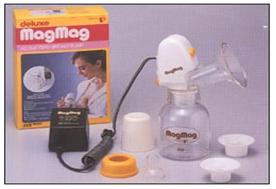
사진 4-93. 젖을 짜는 마그마그 AC 전기 유축기와 배터리 유축기.
출처 Used with permission from MagMag
- 마그마그(MagMag) 유축기는 AC 전기나 배터리로 작동해서 젖을 짤 수 있는 유축기다.
- 변전기나 2AA 배터리로 작동할 수 있는 메들라 소형 전기 유축기(Medela Mini Electric breast pump) 등도 있다.
| 짠 젖을 먹이거나 보관하는 법 |
How to feed mother’s milk expressed by hands or breast pumps and how to save the mother’s milk

사진 4-94. 손으로 짠 젖을 버리든지 바로 먹이든지 냉장고에 보관했다가 차후에 먹일 수 있다.
Copyright ⓒ 2011 John Sangwon Lee, MD., FAAP
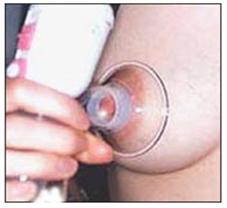
사진 4-95. 유축기로 젖을 짜서 버리든지 바로 먹이든지 보관했다 먹일 수 있다.
Copyright ⓒ 2011 John Sangwon Lee, MD., FAAP
- 젖을 짜기 전 우선 손을 비눗물로 깨끗이 씻는다.
- 젖을 손으로 짜기 전 짠 젖을 받을 컵과 젖병을 물속에 넣고 끓여 살균한다. 살균된 컵이나 젖병 안 쪽을 손으로 더 이상 만져서는 안 된다.
- 젖을 손으로 짜는 동안 손에 닿은 젖은 금방 먹이면 별 문제가 없지만 오랫동안 보관해야 할 때는 버리든지 끓여 살균처리 한 다음에 보관해야 한다(짠 젖을 끓이면 젖에 있는 영양분의 성분이 많이 파괴될 수 있다).
- 손으로 젖을 짜거나 젖 짜는 착유펌프로 젖을 짜기 바로 전 유방 전체를 손으로 마사지한다.
- 젖을 짠 후 아기에게 바로 먹일 때나, 또는 젖을 짠 후 24시간 이내 먹일 때는 냉장고에 얼지 않게 보관할 수 있다. 그러나 젖을 짠 후 24시간 이후에 먹일 때는 냉장고 냉동실 칸에 보관해야 한다.
- 한 번에 짜낸 젖을 한 개의 컵이나 한 개의 젖병에 다 담을 수 없을 정도로 많은 양의 젖양이면 여러 개의 컵이나 젖병에 나누어 담아 보관할 수 있다.
- 또 짠 젖을 냉장고에 얼려 보관했던 젖병에 더 넣어 보관할 수 있다. 30~90cc 정도 담을 수 있는 컵이나 우유병에 넣어서 냉장고의 냉동 칸에 2주 동안 얼려 보관했다가 먹일 수 있고 급속 냉동 칸에 짠 젖을 6개월 동안 보관했다가 먹일 수 있다.
- 필요에 따라 냉장고에 얼려 보관했던 짠 젖을 냉장고에서 꺼낸 후 따뜻한 물로 녹인 후 체온과 비슷한 온도로 다시 덥힌 후 아기에게 먹일 수 있다.
- 아기가 먹다 남긴 짠 젖은 더 이상 보관하지 말고 버린다. 냉장고에서 꺼내서 녹인 후 먹이지 않은 젖도 버린다.
- 짠젖을 라시노 아기 젖병( Lansinoh Baby Bottles for Breastfeeding Babies)에 넣어서 먹이면 아기가 엄마의 젖꼭지를 빨아 모유를 먹는 기분이 난다고 한다. Pediatrics, 4/2016
|
다음은 “1 회용 모유보관 팩에 통한 밤중 수유와 모유수유”에 관한 인터넷 소아청소년 건강상담 질의응답의 예 입니다. |
Q&A. ‘1 회용 모유보관 팩에 통한 밤중수유와 모유수유‘에 관한 인터넷 질의응답 사례
Q.
안녕하세요? 모유에 대한 많은 정보들이 저에게 많은 도움이 될 것 같습니다.
저는 12월 초에 아이를 낳습니다. 그런데 아이가 거꾸로 있어 수술을 합니다.
이때 수술을 하고 나서 아이에게 초유라고 하는 것을 바로 먹여도 괜찮은지 수술을 하게 되면 마취뿐만 아니라 링거도 맞을 것이고 항생제 주사도 맞을 텐데, 걱정이 됩니다.
그렇다고 초유를 안 먹일 수도 없고 그리고, 저는 모유수유를 하더라고 젖을 직접 아이에게 물리기보다는 젖병을 통해서 수유를 하고 싶습니다. 아이에게 계속해서 젖을 물리면 나중에 젖 띠기도 힘이 들고 아이가 젖병을 빨려고 하지 않는다고 해서 말의예요.
그래서 그런데 한 밤 중에 수유를 1회용 모유보관 팩에 보관하였다가 전자렌즈에 데워서 먹이려고 하는데 장기간 이런 1회용 비닐 팩을 통한 방법이 아이의 건강에 어떤 나쁜 영향이 미치는 것은 아닌지 궁금합니다.
그리고 비닐을 전자렌즈에 넣어 데우면 납 성분이 나온다는 말도 있던데,
이런 말들이 사실인지……. 정확하게 알고 싶습니다.
답변 부탁드립니다.
A.
모유수유님
안녕하세요. 아주 전문적이고 중요한 질문을 해주셔서 대단히 감사합니다. 아기에게 모유를 주는 어머님을 보면 저 같은 소아청소년과 의사는 정말로 가슴 속 깊이 감사드리고 싶고 기쁩니다.
몇 자녀를 두고, 자녀들의 터울을 얼마 간격으로 둘 것인지 가족계획을 하고 임신을 하고 임신 중에 열심히 태교를 잘 해서 건강한 아기를 갖기를 원하는 것은 누구에게나 있는 일입니다.
아기가 태어나면 아기에게 가장 좋은 음식물을 주고 싶어 하는 것이 모든 부모들의 마음입니다.
갓 태어난 나의 아기에게 먹이고 싶은 가장 좋은 음식물은 역시 엄마의 젖, 모유입니다.
그런데도 이 세상에 태어난 많은 아기들이 모유를 한 모금도 먹지 못하고 자라기도 합니다.
어떻게 하면 내 자녀에게 초유를 먹일 수 있을까, 어떻게 하면 내 젖을 아기에게 먹일 수 있을까 걱정하는 어머님의 질문을 받고 소아청소년과 의사로서 저는 우선 수유모님께 축하드립니다. 그리고 감사드립니다.
얼마나 많은 산모들이 갓 태어난 아기에게 가장 좋은 음식물인 모유를 주고 싶지만 모유와 모유수유의 가치가 얼마나 큰지 잘 알지도 못하고, 또 모유 수유를 하기 위한 준비를 임신하기 전에도 하지 않고, 임신 중에도 하지 않고 또 모유수유 하는 방법도 잘 몰라서 아예 모유수유를 시도해보지도, 시작도 해보지 않습니다. 이런 면에서 많은 소아청소년과 전문의들은 자책감을 갖기도 합니다.
저 역시 모유를 주지 않고 키운 여식이 있습니다.
하루는 모유수유를 고만하겠다고 결심하고 있는 저의 환아의 부모에게 모유가 얼마나 좋은지를 전화로 장황하게 설명하는 것을 옆에서 듣고 앉아 있던 초등학생 딸이 엄마를 부르더니, “엄마, 나도 젖을 먹었지”라고 엄마에게 묻는 것이었습니다.
저도 마음이 아팠지만.
딸의 질문을 받은 저의 집사람이 상당히 당황하고 있는 것을 봤습니다.
분만 후 갑자기 급성 신장염과 패혈증으로 심히 앓았기 때문에 집사람이 모유수유를 조금 하다가 더 이상 할 수 없어 그 여식에게 인공영양을 먹였기 때문입니다.
엄마의 따뜻한 젖꼭지를 빨게 하는 대신 젖병 꼭지를 빨게 해서 인공영양으로 키운 것이 지금도 가끔 마음이 아픕니다.
엄마에게 건강상 문제가 없으면 모유수유를 하도록 전력을 다 하십시오.
건강상 문제가 있더라도 특별한 경우를 제외하고 적어도 모유수유를 단 며칠 동안만이라도, 또는 몇 주 동안만이라도 꼭 하십시오.
먼 훗날, 자녀분이 제 딸처럼 “엄마, 나도 엄마젖을 먹었지”라고 질문할 때, 어머님이 “물론이지, 나는 너에게 가장 좋은 선물인 모유를 주었다”라고 화답할 준비를 하십시오.
우리는 나, 아내, 남편, 자식이 우리 삶에서 가장 중요한 우선순위라는 것을 가끔 잊곤 합니다. 자식은 우리 생애에서 상당히 중요한 우선순위 위치에 있습니다.
자식은 부모의 삶에서 가장 중요한 줄을 알면서 자식에게 조건 없는 진정한 사랑을 충분히 해주지 못하는 수가 있습니다.
그걸 알면서도 자식에게 진정한 사랑을 충분히 베풀지 못할 수 있습니다.
모유수유는 그 예 중의 하나입니다.
갓 태어난 아기가 엄마 품에 안겨서 엄마의 살갗에 자기의 살갗을 접촉시키면서 받는 신체 접촉 사랑, 엄마의 젖꼭지를 입에 물고 엄마의 젖을 빨 때 느끼는 그 신체적 접촉 사랑은 엄마의 젖꼭지에서 빨아 먹는 모유 속 각종 영양분 이상으로 중요한 것입니다.
그 뿐입니까.
모유수유 중 갓 태어난 아기가 엄마와 눈길을 맞추며 눈길 접촉 사랑을 받는 장면을 보면 모유가 단순히 영양공급을 위한 음식물이라기보다 그 이상 더 많이 있다는 생각이 듭니다.
모유수유는 아기, 수유모, 남편, 온 가족의 정신 건강에도 좋습니다.
나아가서는 그 나라의 국민들의 정신 육체적 건강을 증진 시키는 데도 좋을 것입니다.
저는 이런 여성도 봤습니다.
“내 아들딸에게 모유수유를 하는 동안 내 생애에서 가장 아름다운 나 자신을 발견한 적도 있었다.”
이 밖에도 모유수유의 좋은 점은 너무도 많습니다.
그러나 오늘은 이 정도로 모유의 좋은 점에 관해서 말씀드리도록 하겠습니다.
모유수유와 인공영양 두 가지 중 단 한 가지를 선택해야 할 때는 두말 할 것 없이 모유수유를 선택하십시오. 꼭 말씀 드리고 싶은 것은 인공영양을 먹고도 잘 성장 합니다.
손으로 모유를 짠다든지, 유축기로 모유를 짠다든지 해서 아기에게 모유를 먹이는 법도 있습니다. 그러나 역시 아기가 엄마의 따뜻한 젖꼭지를 직접 입안에 넣고 빨 수 없다는 문제가 있습니다.
또, 아기가 엄마의 젖꼭지를 빨아 직접 모유를 먹지 않으면 신경 임펄스를 통해 뇌하수체 전엽에서 프로랙틴 호르몬 분비가 없기 때문에 유방 내 유선(젖샘)이 자극 받지 않아 모유 분비가 잘되지 않을 수 있습니다.
거기다가 손으로 모유를 짜는 것이나 유축기로 모유를 짜는 것은 때로는 상당히 비능률적일 수 있습니다. 어떤 유축기의 값이 상당히 비싼 데다 한 번 쓰고 버려야 하는 단점도 있고 여러 모로 불편한 점이 많습니다.
아이들의 음식물을 담는 그릇이나 싸는 비닐봉지에 납 성분이 조금이라도 섞여 있으면 그런 그릇을 절대로 사용해서는 안 됩니다. 그런 기구를 제작, 판매하는 것은 법적으로 허가해도 안 되고, 판매도 금지되어야 합니다. 따라서 제 생각에는 납에 관한 걱정을 하실 필요는 없을 것으로 보입니다.
제왕 절개 수술 분만을 한 후에 산모의 건강상태와 갓 태어난 아기가 건강상태가 모유수유를 하기에 적절하면 가능한 한 어느 때든지 젖을 적절히 빨려도 됩니다. 물론 수유 중 젖이 잘 분비되지 않을 것입니다. 태어난 후부터 첫 2~3일 동안은 정상 자연 분만을 한 엄마들의 유방에서도 초유 이외 변이 모유 등 다른 모유가 충분히 분비될 수 없습니다. 더군다나 제왕 절게 수술 분만을 한 엄마의 유방에서 모유가 충분히 분비되지 않을 수 있습니다. 그러나 제왕 절개 분만이나 산모에게 치료 상 쓴 약물 때문에 모유수유를 중단할 필요는 거의 없습니다.
다만, 제왕 절개 수술로 분만한 산모는 긴장과 피로를 더 많이 받고, 수술 등으로 인한 통증이 더 심할 수 있습니다. 이런 이유로 모유분비가 잠시 동안 잘되지 않을 수 있습니다. 그렇지만 분만 후 초유는 2-3일까지 분비됩니다. 초유를 먹이고 계속 젖을 빨리면 뇌하수체 전엽에서 분비되는 프로랙틴 호르몬이 유선을 자극해서 모유가 정상적으로 생성 분비되고 아기가 그 모유를 어느 정도 충분히 먹기 시작할 수 있습니다. 또 그 후 모유도 더 잘 분비될 수 있습니다. 모유도 수유하고 보충용 인공영양을 먹이면 모유를 더 이상 먹지 않으려는 아기들도 있습니다. 아기가 모유를 충분히 먹지 않는 것 같으면 의사의 지시에 따라 5%~10% 포도당 물을 먹일 수 있고 모유를 대신해 보충할 수 있는 인공영양을 필요에 따라 응급 보충용으로 한두 번 줄 수 있습니다.
모유를 계속 먹이다가 모유가 충분히 나오기 시작하면 보충용 포도당액이나 인공영양을 더 이상 주지 말고 모유만 먹일 수 있습니다. 그러나 이렇게 모유 대신 주는 보충용 포도당액, 인공영양을 일체 먹이지 말라도 하는 의사들도 많이 있습니다.
모유수유를 성공하시길 빕니다. 질문이 있으면 다시 연락해주시기 바랍니다. 감사합니다. 이상원 드림
표 5-1. 짠 젖을 얼마나 오랫동안 보관했다가 먹여도 안전한가.
| 짠 젖을 보관하는 장소 | 짠 젖을 보관할 때의 온도 | 짠 젖을 보관할 수 있는 시간이나 개월 수 |
| 실내 | 화씨 77도/ 섭씨 25도 | 4시간 |
| 청색 아이스 쿨러 | 화씨 59도/ 섭씨 15도 | 24시간 |
| 냉장고(새로 짠 젖) | 화씨 39도/ 섭씨 4도 | 72시간 |
| 냉장고(전에 짜서 얼렸다 녹힌 젖) | 화씨 39도/ 섭씨 4도 | 24시간 |
| 얼린 젖 | 화씨 4도/ 섭씨 -20도 | – |
| 1. 냉장고 냉장 칸 | – | 2주일 |
| 2. 냉장고 냉동 칸(문이 냉장고에도 달려있고 냉동칸에도 달려 있는 냉장고) |
– | 3~6개월 |
| 3. 손으로 따로 작동하는 얼음 녹이는 칸 | – | 6~12개월 |
Breast milk expressed by manual technique or breast milk pump, 맨 손이나 유축기로 젖을 짜야 하는 경우
It is best if a nursing mother tries to baby suck the nipple directly to breastfeed the baby, but sometimes, for unavoidable circumstances, it is unavoidable that the baby has to eat express milk with a bare hand or a breast pump and feed the baby with a bottle.
The mother’s milk can be squeezed in advance, placed in a bottle, stored in the refrigerator, and then the squeezed milk can be fed to the baby by a nursing mother.
In what cases should these alternatives be used?
When the mother’s breast is swollen and the “breast overfilling” phenomenon occurs, the breast can be milked with a hand or a breast pump for therapeutic purposes.
This method can also be used when the nursing mother is working full-time or when she has to go out for a long time and cannot breastfeed her baby for more than 4 to 5 hours.
Before going to work or going out, you can squeeze the milk with your bare hands or store it with a breast pump, and then feed your baby with the milk on time. When a baby who has been breastfed by her mother is fed artificial nutrition as a supplement, some babies do not like to take artificial nutrition, and some babies refuse to take artificial nutrition at all. Some babies are allergic to artificial nutrition and do not eat. Instead of feeding these babies with supplementary artificial nutrition, they can squeeze and store her mother’s milk, and then feed the squeezed mother’s milk in a bottle. Some of the very small, low-weight, premature newborns have no primitive reflexes, such as the sucker reflex or the breast reflex, and they don’t even have the power to suck on her nipples, so they can’t put the mother’s nipples in her mouth and suck them. Very weak, premature infants (Preterm), very low birth weight infants, extremely low birth weight infants, who are unable to feed their mother’s milk due to some disease. There are also low birth weight infants.
These immature newborns, no matter how adequately breastfeeding their mothers, cannot suck on her nipples well and cannot suck on enough of her milk. In this case, the mother’s milk can be squeezed with bare hands or a breast pump and placed in a sterilized bottle to feed the squeezed milk to an immature newborn baby immediately, or store the squeezed milk and feed it with a dropper, tube nutrition (tube feeding), or a bottle.
(Parents should also be at least the half-doctors-Refer to the Encyclopedia of Pediatrics and Family Nursing-Volume 6, Newborn Growth and Developmental Diseases-Very Small Immature Newborns)
As an indispensable problem, there may be cases where a nursing mother and a nursing baby must be separated from each other for 4 to 5 hours or more.
In this case, the mother cannot feed her baby directly, so she can also squeeze her milk with her bare hand or with a breast pump and place it in her bottle to feed the baby. It may be that the mother is sick or the baby is sick and cannot feed her mother’s breast milk to the baby, or the baby is sick and the baby cannot suck on her mother’s breast milk.
Also, you can squeeze your milk with your bare hand or with a breast pump and put it in a bottle to feed the baby. If you feed only the milk that is stored in the anterior part of the breast and not the milk that is stored in the back part of the breast, your baby will only eat the milk in the anterior part, which has a small amount of calories per unit dose, and the baby will not be able to eat enough milk that is stored in the posterior part of the breast, which has higher calories.
If you breastfeed your baby in this way, it will be difficult to produce milk. In addition, the baby can eat enough mother’s milk quantitatively, but not enough in terms of calories.
Even if your baby eats enough amount of breast milk at the proper feeding intervals, your baby can quickly become hungry or lose weight.
The rear portion of the leftover milk can be milked and stored and fed. When breastfeeding, the entire breast is massaged just before, during, and immediately after breastfeeding, and the breast must be completely empty by squeezing the milk from the back of the breast with a hand or a breast pump so that the next line of milk is better secreted.
There are times when milking is necessary to avoid exacerbation of mastitis (mastitis) or bacterial infectious mastitis, which may be caused by a blockage of the canal.
You cannot breastfeed properly even when your nipples are sore and cracked. At this time, you can also express the milk with your bare hand or with a breast pump and feed the squeezed milk with a bottle. Now let’s take a closer look at how to express milk by hand and how to express milk with a pump in each section.

Photo 4-80. If necessary, milk with your bare hands or with a breast pump. Copyright ⓒ 2011 John Sangwon Lee, MD., FAAP

Photo 4-81. There are several types of breast pumps. The photo shows a breast pump that milks by hand. Copyright ⓒ 2011 John Sangwon Lee, MD., FAAP
How to express milk with bare hands
How to manually express breast milk.
First, wash your hands and massage the entire breast by hand (see Breast Massage). After the massage, place one thumb and finger on the breast area 3.5cm away from one nipple, and support the lower part of the breast on the same side with the other fingers of the same hand.
Then, gently press the breast toward the anterior chest wall and push it slightly toward the nipple to squeeze. Press gently on the same part of the breast until no more milk comes out, and finally place your finger on the areola part and express the milk there.
Do not pull the nipple forward at this time. When there is no more milk coming out of that part of the breast, move your hand to another part of the breast that is right next to it and squeeze it in the same way.
The time it takes to express one milk depends on many conditions and circumstances, but it takes about 20 to 30 minutes if the milk has not been fed for a long time. Cups that will receive squeezed milk should be sterilized with boiling water before milking.
After receiving the milk squeezed in a sterilized cup, transfer it to a sterilized bottle. You can feed the milk from the cup to your baby right away, or you can transfer the milk to a bottle and store it in a refrigerator freezer for 2 weeks.
Alternatively, you can keep it in the freezer quick freezer for 6 months before feeding it to your baby. However, after dissolving the milk stored in the freezer compartment or the quick-freezing compartment of the refrigerator once and feeding it, you must discard any remaining wet milk. Also, for convenience, it is better not to contain more than 90~120cc of breast milk in one bottle.
For various reasons, when a baby cannot be fed for more than 1 day and needs to be kept after milking, it is not possible to determine uniformly how often to milk, but it is usually possible to express it 8 times in 24 hours. You can milk every three hours during the day, and you don’t have to do it when you sleep at night.
However, breast milk is secreted better by milking every 3 to 4 hours regardless of day or night. You can milk a few times as needed and store them in one bottle.
If your baby sleeps more than 4 to 5 hours at night, milk and store it before going to sleep or when you wake up early in the morning. If the breast is massaged immediately after feeding, the pituitary gland secretes prolactin hormone and Pitocin hormone, which stimulates the breast to secrete more milk. After that, milking by hand can result in more milk being released and the milk can be stored in a bottle. At this time, you can milk alternately from the left and right breasts and milk from both the left and right breasts at the same time.
A breast massage just before or during milking can produce more milk and produce more milk.
After delivery, learning how to hand milk from a nurse or from a breastfeeding specialist in the hospitalization room and how to store squeezed milk will be useful at home when you need it after you are discharged from the hospital. After delivery, it would be better if the medical law stipulates that all nursing mothers must receive special education on breastfeeding from a breastfeeding expert before the nursing mothers and newborns are discharged from the hospital.

Photo 4-82. Place your thumb and finger on the front part of the breast that is 3.5cm away from the nipple, gently press the breast toward the front chest wall, and gently squeeze the breast with your bare hands while pushing it slightly in front of the nipple. Press the front part of the breast until there is no more milk, and finally place your fingers on the nipple and areola area to squeeze. Copyright ⓒ 2011 John Sangwon Lee, MD., FAAP

Photo 4-83. When milking with bare hands, do not pull the nipple forward. Wash your hands thoroughly with soapy water before milking with your bare hands. Copyright ⓒ 2011 John Sangwon Lee, MD., FAAP

Photo 4-84. Use both hands to gently squeeze the milk. Copyright ⓒ 2011 John Sangwon Lee, MD., FAAP

Photo 4-85. Milk is expressed in a sterile sterilized cup, and the squeezed milk is transferred to a bottle. squeezed milk can be infected by bacteria, and if not stored well, bacteria can grow in the milk. Copyright ⓒ 2011 John Sangwon Lee, MD., FAAP
How to express milk with a manual breast pump
How to express breast milk by the manual breast pumps
The device for milking is called a breast pump.
In other words, it is also called a milking machine, breast pump, or milk pump. According to the operating principle of the breast pump
- ‘Manual breast pump’ that milks by operating with bare hands,
- ‘Battery pumping machine’ that milks by operating with a battery,
- There are several types, such as’electric breast pumps’ that are operated with electricity to express milk.
Manual breast pumps that can be milked with bare hands are inexpensive, easy to carry wherever you go, and easy to use. However, the disadvantage is that the milking effect is not very good.
Types of manual breast pumps that can be milked with bare hands
- Bicycle horn breast pump,
- Evenflo breast pump,
- Le Pump breast pump,
- Nurture breast pump,
- Ora’ Lac breast pump,
- Lloyd-B breast pump,
- Cylinder breast pump,
- Egnell Hand breast pump,
- Comfort Plus breast pump,
- The Medela Manual or Electric breast pump is a manual breast pump that can be milked with bare hands.
There are also breast pumps that can be pumped by operating with your feet, such as the Pedal Pump and Breast Pump.
Here, some typical types of manual breast pumps will be described. (For reference, the brand name of breast pump is for the convenience of readers, and there is no interest in the author.)
① Breast pump operated with bare hands
It is a kind of manual breast pump that can be milked by operating with bare hands. There is a small suction port on one side and a funnel opening at the other end. The tip of the funnel opening is placed in close contact with the front part of the breast including the nipple and the nipple ring, and the milk is squeezed when the suction port is pressed and unfolded by hand. Before attaching the end of the funnel inlet shape to the front part of the breast, press the inlet containing air firmly to drain all the air in the inlet to create negative pressure.
Then, the end of the funnel inlet shape was brought into close contact with the front part of the breast. The principle is that when unfolding, negative pressure and positive pressure are created in the suction port, and milk is squeezed.
A manual breast pump that expresses milk by hand has the disadvantage that it is more difficult to express and does not express the milk well compared to a breast pump that expresses milk by operating with a battery or electricity. Incorrect milking can injure the breast, contaminate bacteria at the mouth of the manual breast pump, and are difficult to sterilize. (Refer to Figure 5-9)
② Cylinder breast milk pumps

Figure 4-26 A type of manual breast pump that is hand-operated to milk Copyright ⓒ 2011 John Sangwon Lee, MD, FAAP

Photo 4-86. Cylindrical manual breast pump. Copyright ⓒ 2011 John Sangwon Lee, MD,, FAAP

Photo 4-87. Disassembled cylindrical manual breast pump. Copyright ⓒ 2011 John Sangwon Lee, MD,, FAAP
In a cylindrical manual breast pump, two large and small cylinders are superimposed.
Put a small inner cylinder in a large outer cylinder, and press the funnel-shaped opening on the large cylinder to the front part of the breast, and when pulling it from the breast side, the milk is milked. Cylindrical manual breast pumps are available in two types: one with a straight portion on the front of the breast and one with a slightly inclined one. When milking with a cylindrical manual breast pump, it is common to express milk by operating it with two hands.
It is a little uncomfortable because it puts a lot of power into the hand when milking, but it is a manual breast pump that is widely used because it is relatively well squeezed.
There are also cylindrical breast pumps that use battery-operated milk.
The Egnell Hand breast pump and the Comfort Plus breast pump are a kind of cylindrical manual breast pump.
③ Manual trigger breast milk pumps
The trigger-type manual breast pump has a plastic handle, and on the opposite side is a funnel-shaped end. The tip of the funnel opening is pressed against the front part of the breast, and the trigger-shaped handle is pressed and released by hand to produce milk. The effect of milking is better than when milking with a bicycle horn-type manual breast pump. Before milking with this trigger type manual breast pump, you should practice how to express your milk correctly. If the nursing mother’s hand is small, it will be a little uncomfortable to use. The Lloyd-B breast pump is a type of trigger type manual breast pump. There are many other types of manual breast pumps that can be pumped by hand.

Photo 4-88. Trigger type manual breast pump Copyright ⓒ 2011 John Sangwon Lee, MD, FAAP

Photo 4-89. Trigger type manual breast pump Copyright ⓒ 2011 John Sangwon Lee, MD., FAAP
How to express milk with a battery pump How to express breast milk by battery-operated breast milk pumps
One of the most common breast pumps these days is a battery breast pump.
The battery breast pump is a breast pump that can milk completely automatically using the power of the battery. There is an advantage in that there is no hand pressure when milking with a battery breast pump. It is light and convenient to carry.
On the other hand, the price is a little more expensive than a manual breast pump. You have to change the battery as needed. Battery breast pumps include the Egnell Lact-B battery breast pump, the Natural Choice battery breast pump, and the Gentle Expressions battery breast pump. Refer to the milking machine manufacturer’s information for more detailed instructions. How to milk with an AC electric breast pump How to express breast milk by AC electric breast milk pumps Photo 4-90. Lactina double breast pump. Source Breastfeeding Information Guide, Medela

Picture 4-91. Small battery (battery) breast pump. Source: Medela. Inc. P. o. Box. Mchenry. Il.60051-0660]

Photo 4-92. Eggshell AC electric breast pump. Sauce Eggsnell Copyright ⓒ 2011 John Sangwon Lee, MD., FAAP
It is an AC electric breast pump that can be operated with AC electricity to milk. It has the advantage of being able to milk easily with one hand without effort. Milk is milked as easily as when a baby sucks on a mother’s nipple. Some electric breast pumps are quite heavy and expensive. Some are lighter and others are cheaper.
AC electric breast pump Eggshell electric breast pump, Medela mini electric breast pump, Lactina breast pumps, Axicare CM-10 electric breast pump, Axicare CM-6 electric breast pump, Precious Care electric breast pump, There are several types, including the Isis Avent electric breast pump.
For reference, the names and information of breast pumps listed here are public information for the convenience of readers who have no interest in the author or publisher.
AC electric breast pump and battery breast pump AC electric breast milk pumps and Battery-operated breast milk pumps

Photo 4-93. Milking Magmag AC electric breast pump and battery breast pump. Source Used with permission from MagMag The MagMag breast pump is a breast pump that can be milked either by AC electricity or by battery operation.
There are also the Media Mini Electric breast pumps that can be powered by substations or 2AA batteries.
How to feed or store squeeze milk How to feed mother’s milk expressed by hands or breast pumps and how to save the mother’s milk

Photo 4-94. Whether you throw away hand-wrapped milk or feed it right away, you can keep it in the refrigerator and feed it later. Copyright ⓒ 2011 John Sangwon Lee, MD., FAAP

Photo 4-95. It can be kept and fed whether it is milked with a breast pump and discarded or fed right away. Copyright ⓒ 2011 John Sangwon Lee, MD., FAAP
Before milking, wash your hands thoroughly with soapy water.
Before milking by hand, put the cup and bottle to receive the milk into the water and boil it for sterilization.
You should no longer touch the inside of a sterile cup or bottle with your hands.
While milking by hand, it is not a problem if you feed it quickly, but if you need to keep it for a long time, it should be discarded or boiled and sterilized before storing (boiling squeeze milk can destroy a lot of nutrients in the milk). Hand-massage the entire breast just before milking with a hand-wrapped or milking pump.
It can be stored in the refrigerator to prevent freezing when feeding to a baby immediately after milking, or when feeding within 24 hours after milking.
However, when feeding after 24 hours after milking, it should be stored in the freezer compartment of the refrigerator. If the amount of milk that is squeezed at a time cannot be contained in one cup or bottle, it can be stored in several cups or bottles. In addition, squeezed milk can be stored in a bottle that was frozen in the refrigerator and stored.
You can put it in a cup or milk bottle that can hold 30~90cc and freeze it in the freezer compartment of the refrigerator for 2 weeks before feeding, and you can store the milk squeezed in the quick-freezing compartment for 6 months before feeding.
If necessary, you can take out the squeezed milk that was frozen and stored in the refrigerator from the refrigerator, dissolve it with warm water, reheat it to a temperature similar to the body temperature, and feed the baby.
Don’t store the squeezed water left over by your baby and throw it away.
Take it out of the refrigerator, melt it, and throw away any unfed milk.
The following is an example of the Internet pediatric and adolescent health counseling question and answer on “Night feeding and breastfeeding through a disposable breast milk storage pack”.
Q&A.
Internet Q&A one night Feeding and Breastfeeding through a Single Use Breast Milk Storage Pack’ Q. Good morning?
I think a lot of information about breast milk will help me a lot. I have a child in early December. However, the child is upside down and has surgery.
At this time, whether it is okay to feed the child with something called colostrum immediately after the operation, if the operation is performed, not only anesthesia, but also Ringer will be given and antibiotic injections will be given, but I am worried. That doesn’t mean that I can’t stop feeding colostrum, and even if I’m breastfeeding, I want to breastfeed through a bottle rather than biting my child directly. It makes sense to say that if you keep breastfeeding your child, it will be difficult to breastfeed later and the child will not try to suck the bottle.
So, by the way, I am trying to feed the breastfeeding in a disposable breastfeeding pack in the middle of the night and then warm it up in an electronic lens.
There is also a saying that lead is released when vinyl is heated in an electronic lens. Are these words true… … . I want to know exactly. please answer about my question.
A.
Breastfeeding Good morning.
Thank you very much for asking a very professional and important question. When I see a mother who breastfeeds her baby, a pediatrician like me really wants to be deeply grateful and happy. Whoever wants to have a healthy baby by having a family plan for how many children and how many intervals the children will have, getting pregnant, and having a good prenatal child during pregnancy. When a baby is born, it is the heart of all parents to want to give them the best food. The best foods I want to feed my newborn baby are also mother’s milk and breast milk. Nevertheless, many babies born in this world grow up without a single sip of breast milk.
As a pediatrician, as a pediatrician, I congratulate the nursing mother first after receiving a question from my mother who is worried about how to feed my child with colostrum and how to feed my baby with my baby. And thank you.
How many mothers want to give their newborn baby the best food, breast milk, but do not know how much the value of breast milk and breastfeeding is, and do not prepare for breastfeeding or breastfeeding before or during pregnancy.
I don’t even know how to breastfeed, so I don’t even try or start breastfeeding at all. In this regard, many pediatricians and specialists have a feeling of self-confidence.
I also have food that I have grown without breastfeeding.
One day, the daughter of an elementary school student, who was sitting next to listening to the phone explaining how good breast milk is to the parents of my patient, who is determined to refrain from breastfeeding, called her mother.
I was asking my mom. Even though I was in pain. I saw my wife, who was asked her daughter’s question, was quite embarrassed. This is because my wife was suffering from acute nephritis and sepsis suddenly after delivery, so my wife was able to breastfeed a little and then couldn’t do it anymore, so she fed the woman with artificial nutrients. Instead of sucking her mother’s warm nipples, it hurts her heart sometimes to suck her bottle nipples and grow them with artificial nutrition. If her mom doesn’t have any health problems, do her best to breastfeed her. Even if you have a health problem, be sure to breastfeed for at least a few days or weeks, except in special cases. In the distant future, when your child asks, like my daughter,
“Mom, I have breast milk too”, be prepared to respond to your mother saying, “Of course, I gave you breast milk, which is the best gift.”
We sometimes forget that I, my wife, my husband, and my children are the most important priorities in our lives. Children are a very important priority in our lives.
Children knowing what is most important in their parents’ lives may not give them enough true unconditional love. Even knowing that, you may not be able to show enough true love for your children. Breastfeeding is one example. The love of physical contact received when a newborn baby is held in the mother’s arms and touches his/her skin with the mother’s skin. It’s more important than nutrients. That’s all it is. When I see a scene where a newborn baby is loved by eye contact while making eye contact with her mother while breastfeeding, I feel that there is more than just food for nutritional supply. Breastfeeding is also good for the mental health of babies, nursing mothers, husbands and the whole family.
Furthermore, it will be good for improving the mental and physical health of the people of that country. I’ve also seen women like this. “While breastfeeding my son and daughter I found myself the most beautiful of my life.” There are so many other good things about breastfeeding. However, today I will tell you about the benefits of breast milk. When you have to choose between breastfeeding and artificial nutrition, let alone breastfeed.
What I really want to say is that it grows well even after eating artificial nutrition. There are also ways to breastfeed your baby, such as by hand-squeezing or using a breast pump. However, there is also the problem that the baby cannot put her mother’s warm pacifier directly into her mouth and wash it. In addition, if the baby does not directly feed on the mother’s nipples by sucking on the mother’s nipples, there is no secretion of the hormone prolactin from the anterior pituitary gland through nerve impulses. In addition, expressing breast milk by hand or with a pump can sometimes be quite inefficient. Some breast pumps are quite expensive, have the disadvantage of having to use them once and throw them away, and have many inconveniences.
Bowls or plastic bags for children’s food should never be used if they contain any lead content. The manufacture and sale of such equipment should not be legally permitted, nor should the sale be prohibited.
So I don’t think you need to worry about lead. After cesarean section delivery, if the mother’s health condition and the newborn baby’s health condition are adequate to breastfeed, milk may be sucked appropriately whenever possible.
Of course, you will not be able to secrete your milk during lactation. During the first 2 to 3 days after birth, the breasts of mothers who have delivered a normal natural delivery cannot sufficiently secrete other breast milk, such as colostrum and stool breast milk.
Furthermore, the breasts of mothers who have delivered cesarean section surgery may not secrete enough breast milk. However, it is seldom necessary to stop breastfeeding for a cesarean delivery or for drugs used for treatment in the mother. However, mothers who are delivered by cesarean section may experience more tension and fatigue, and may have more pain caused by surgery. For this reason, breast milk secretion may not work well for a while.
However, colostrum is released until 2-3 days after delivery. If you continue to breastfeed after feeding colostrum, the prolactin hormone secreted from the anterior pituitary gland stimulates the mammary gland to produce and secrete breast milk normally, and the baby can begin to eat enough of that milk. In addition, breast milk may be secreted better after that. Some babies may not want to breastfeed any more if they are breastfeeding and given supplemental nutrition. If your baby doesn’t seem to be eating enough breast milk, you can get 5% to 10% glucose water as directed by your doctor, and artificial nutrients to replace breast milk can be given once or twice as an emergency supplement as needed. If you continue to breastfeed and start to produce enough breast milk, you can no longer give supplemental glucose or artificial nutrients, but only breast milk. However, there are many doctors who ask you not to give any supplementary glucose solution or artificial nutrients instead of breast milk. We wish you successful breastfeeding. If you have any questions, please contact us again.
Thank you. Lee Sang-won .MD
Table 5-1. How long is it safe to keep and feed expressed milk?
표 5-1. 짠 젖을 얼마나 오랫동안 보관했다가 먹여도 안전한가.
| Where expressed milk is stored | the temperature when salty milk is stored | The number of hours or months that salty milk can be stored |
| Indoor | degrees Fahrenheit 77/ degrees Celsius 25 | 4 hour |
| Blue Ice Cooler | degrees Fahrenheit 59/ degrees Celsius 15 | 24 hour |
| Refrigerator (fresh milk) | degrees Fahrenheit 39/ degrees Celsius 4 | 72 hour |
| Refrigerator (pre-squeezed and frozen milk and unmelted milk) | degrees Fahrenheit 39/ degrees Celsius 4 | 24hour |
| Frozen breast milk | degrees Fahrenheit 4/ degrees Celsius -20 | – |
| 1. Refrigerator Frozen compartment 냉장 칸 | – | 2 week |
| 2.Refrigerator freezer compartment (the door is also attached to the refrigerator compartment) | – | 3~6 months |
| 3. Hand-operated ice-melting compartment | – | 6~12 months |
참조문헌 및 출처
- NelsonTextbook of Pediatrics 22ND Ed
- The Harriet Lane Handbook 22ND Ed
- Growth and development of the children
- Red Book 32nd Ed 2021-2024
- www.drleepediatrics.com 제1권 소아청소년 응급 의료
- www.drleepediatrics.com 제2권 소아청소년 예방
- www.drleepediatrics.com 제3권 소아청소년 성장 발육 육아
- www.drleepediatrics.com 제4권 모유,모유수유, 이유
- www.drleepediatrics.com 제5권 인공영양, 우유, 이유식, 비타민, 미네랄, 단백질, 탄수화물, 지방
- www.drleepediatrics.com 제6권 신생아 성장 발육 육아 질병
- www.drleepediatrics.com제7권 소아청소년 감염병
- www.drleepediatrics.com제8권 소아청소년 호흡기 질환
- www.drleepediatrics.com제9권 소아청소년 소화기 질환
- www.drleepediatrics.com제10권. 소아청소년 신장 비뇨 생식기 질환
- www.drleepediatrics.com제11권. 소아청소년 심장 혈관계 질환
- www.drleepediatrics.com제12권. 소아청소년 신경 정신 질환, 행동 수면 문제
- www.drleepediatrics.com제13권. 소아청소년 혈액, 림프, 종양 질환
- www.drleepediatrics.com제14권. 소아청소년 내분비, 유전, 염색체, 대사, 희귀병
- www.drleepediatrics.com제15권. 소아청소년 알레르기, 자가 면역질환
- www.drleepediatrics.com제16권. 소아청소년 정형외과 질환
- www.drleepediatrics.com제17권. 소아청소년 피부 질환
- www.drleepediatrics.com제18권. 소아청소년 이비인후(귀 코 인두 후두) 질환
- www.drleepediatrics.com제19권. 소아청소년 안과 (눈)질환
- www.drleepediatrics.com 제20권 소아청소년 이 (치아)질환
- www.drleepediatrics.com 제21권 소아청소년 가정 학교 간호
- www.drleepediatrics.com 제22권 아들 딸 이렇게 사랑해 키우세요
- www.drleepediatrics.com 제23권 사춘기 아이들의 성장 발육 질병
- www.drleepediatrics.com 제24권 소아청소년 성교육
- www.drleepediatrics.com 제25권 임신, 분만, 출산, 신생아 돌보기
- Red book 29th-31st edition 2021
- Nelson Text Book of Pediatrics 19th- 21st Edition
- The Johns Hopkins Hospital, The Harriet Lane Handbook, 22nd edition
- 응급환자관리 정담미디어
-
소아가정간호백과–부모도 반의사가 되어야 한다, 이상원
-
Neonatal Resuscitation American heart Association
-
Neonatology Jeffrey J.Pomerance, C. Joan Richardson
-
Pediatric Resuscitation Pediatric Clinics of North America, Stephen M. Schexnayder, M.D.
-
Pediatric Critical Care, Pediatric Clinics of North America, James P. Orlowski, M.D.
-
Preparation for Birth. Beverly Savage and Dianna Smith
-
Infectious disease of children, Saul Krugman, Samuel L Katz, Ann A. Gershon, Catherine Wilfert
- Pediatric Nutritional Handbook American Academy of Pediatrics
- 소아가정간호백과–부모도 반의사가 되어야 한다, 이상원
- The pregnancy Bible. By Joan stone, MD. Keith Eddleman, MD
- Neonatology Jeffrey J. Pomerance, C. Joan Richardson
- Preparation for Birth. Beverly Savage and Dianna Smith
- 임신에서 신생아 돌보기까지. 이상원
- Breastfeeding by Ruth Lawrence and Robert Lawrence
- Infectious disease of children, Saul Krugman, Samuel L Katz, Ann A. Gershon, Catherine Wilfert
- The Harriet Lane Handbook 19th Edition
- 제4권 모유, 모유수유, 이유 참조문헌 및 출처
- 제5권 인공영양, 우유, 이유, 비타민, 단백질, 지방 탄수 화물 참조문헌 및 출처
- 제6권 신생아 성장발육 양호 질병 참조문헌 및 출처
- 소아과학 대한교과서
- 그 외